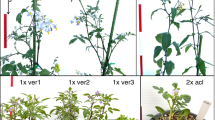Summary
The role of polyploidy in the evolution of the sweet potato. I. batatas (2n=6x=90), became more clear in 1971 when wild species with 30, 60, and 90 chromosomes were discovered. These species, I. leucantha (2x), I. littoralis (4x) and I. trifida (6x), are the progenitors of the sweet potato (6x), in an autopolyploid series with doubling of the I. leucantha B genome.
In the present study the hypothesis of the origin of the sweet potato was confirmed by comparative studies on some plant characters, sexual compatibility, and the behavior of artificial hexaploids produced from I. leucantha (2x) and I. littoralis (4x).
Since induced hexaploid I. leucantha exhibits weak growth, a few multivalents are formed at meiosis in the sweet potato, and there are differences in morphological and physiological characteristics between the artificial hexaploids and I. batatas, raw autoploidy seems unlikely, but a balanced or diploidised autoploidy could have been achieved by genic and chromosomal changes in the course of evolution. However, there is still sufficient homology so that meiotic pairing occurs usually between regular partners but also between homoeologous chromosomes in a certain situation.
Similar content being viewed by others
References
Jones, A., 1965. Cytogenetical observations and fertility measurements of sweet potato (Ipomoea batatas (L.) Lam.) Proc. Amer. Soc. hort. Sci. 86: 527–537.
Jones, A. & M. T. Deonier, 1965. Interspecific crosses among Ipomoea lacunosa, I. romoni, I. trichocarpa, and I. triloba. Bot. Gaz. 126: 226–232.
Jones, A., 1967. Should Nishiyama's K 123 (Ipomoea trifida) be designated I. batatas? Econ. Bot. 21: 163–166.
Jones, A. & M. Kobayashi, 1968. Derived polyploids of section Batatas genus Ipomoea. Proc. Amer. Soc. hort. Sci. 93: 497–501.
Kihara, H. & I. Nishiyama, 1932. Different compatibility in reciprocal crosses of Avena, with special reference to tetraploid hybrids between hexaploid and diploid species. Japan. J. Bot. 6: 245–305.
Magoon, M. L., R. Krishnan & K. VijayaBai, 1970. Cytological evidence on the origin of sweet potato. Theor. appl. Genet. 40: 360–366.
Martin, F. W. & A. Jones, 1972. The species of Ipomoea closely related to the sweet potato. Econ. Bot. 26: 201–215.
Nishiyama, I., 1959. Collecting the sweet potato and its allied species in U.S.A. and Mexico. Japan. J. Breeding 9: 73–78.
Nishiyama, I., 1961. The origin of the sweet potato plant. Tenth Pacific Sci. Congr., Honolulu, Hawaii, U.S.A., Aug. 21 to Sep. 6, 1961. In: J. Barrau (Ed.). The symposium ‘Plants and the migrations of Pacific peoples’, 1963: 119–128.
Nishiyama, I., 1971. Evolution and domestication of the sweet potato. Bot. Mag. Tokyo 84: 377–387.
Nishiyama, I., K. Fujise, T. Teramura & T. Miyazaki, 1961a. Comparative investigations on the chromosome numbers and the main characters of Ipomoea species in section Batatas. Japan. J. Breeding 11: 37–43.
Nishiyama, I., K. Fujise, T. Teramura & T. Miyazaki, 1961b. Physiological and ecological and ecological characters of K 123 (Ipomoea trifida (H.B.K.) G. Don.). Japan. J. Breeding 11: 261–268.
Nishiyama, I. & T. Teramura, 1962. Mexican wild form of sweet potato. Econ. Bot. 16: 304–314.
Sakamoto, S., 1970. Utilization of related species on breeding of sweet potato in Japan. Japan. agric. Res. Quarterly 5 (4): 1–4. Published by Trop. Agr. Res. Center, Japan.
Shiotani, I., I. Nishiguchi & S. Mitsuishi, 1970. Cytogenetic studies of basic genomes for producing sweet potato. (Japanese). In: T. Kawase, (Ed.), Studies on the artificial synthesis of sweet-potato plants. (Japanese, mimeograph). pp. 36–68. Tsu, Mie Prefecture, Univ. Mie.
Ting, Y. C. & A. E. Kehr, 1953. Meiotic studies in the sweet potato (Ipomoea batatas Lam.). J. Heredity 44: 207–211.
Author information
Authors and Affiliations
Rights and permissions
About this article
Cite this article
Nishiyama, I., Miyazaki, T. & Sakamoto, S. Evolutionary autoploidy in the sweet potato (Ipomoea batatas (L.) Lam.) and its progenitors. Euphytica 24, 197–208 (1975). https://doi.org/10.1007/BF00147186
Received:
Issue Date:
DOI: https://doi.org/10.1007/BF00147186




